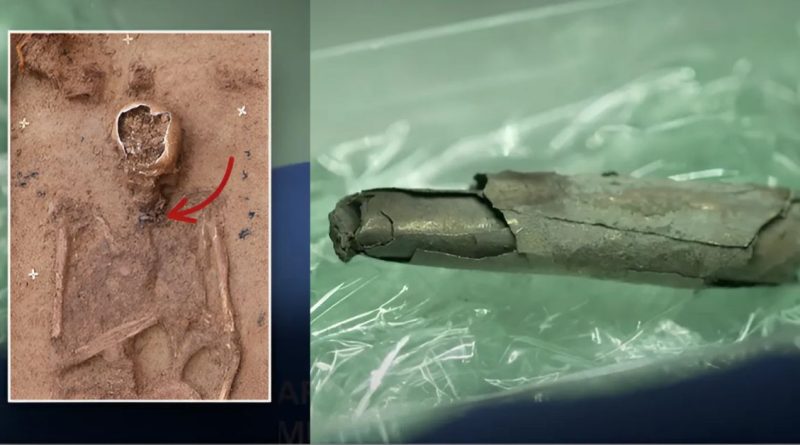Ancient Silver Amulet Reveals Earliest Evidence of Christianity North of the Alps, Rewriting History
Frankfurt, Germany – A groundbreaking discovery by archaeologists in Germany is shedding new light on the early spread of Christianity in Europe, pushing back the timeline for its presence north of the Alps by at least half a century. The Frankfurt Archaeological Museum recently unveiled a tiny, intricately inscribed silver amulet, dating back to between 230 and 260 AD, that provides the earliest known “purely Christian” artifact found in this region. This finding, heralded as one of the “most important testimonies of early Christianity worldwide,” is set to revolutionize our understanding of this pivotal period in religious history.
A Remarkable Find from the Roman City of Nida
Unearthed in 2018 during excavations in Hesse, Germany, within the grounds of the former Roman city of Nida, the amulet was found within a third-century grave. After years of meticulous analysis and restoration, the museum finally revealed the secrets held within this delicate silver foil. Known as the “Frankfurt silver inscription,” the amulet is adorned with 18 lines of Latin text, a powerful declaration of Christian faith that begins with an invocation to Saint Titus, a prominent figure in early Christianity and a disciple of Paul the Apostle.
Unveiling the Message: A Painstaking Process
Deciphering the inscription was no easy feat. The silver foil, rolled up for nearly 1,800 years, was severely deteriorated. Archaeologists employed cutting-edge technology, including computed tomography, to digitally “unroll” the fragile artifact and reveal the hidden text. Professor Markus Scholz of Goethe University, who led the translation effort, described the painstaking process, which involved collaborating with theological historians and meticulously piecing together the fragmented message.
“Sometimes it took weeks, even months, for me to have the next idea,” Scholz stated, highlighting the challenges involved in translating such an ancient and damaged inscription. However, the team’s persistence paid off, revealing a remarkably sophisticated piece of writing penned by, as Scholz described, “an elaborate writer.”
A Purely Christian Declaration, Unprecedented for its Time
The inscription, once fully translated, proved to be a powerful testament to Christian belief. It calls for protection for “the man who gives to the will the Lord Jesus Christ, God’s Son” and concludes with the declaration, “The heavenly, the earthly and the underground, and every tongue confess (to Jesus Christ).”
What sets this inscription apart from other contemporary finds is its exclusively Christian nature. While most amulets from this era typically show a blend of Christian, Jewish, and pagan influences, the Frankfurt silver inscription is devoid of any references to Judaism or pagan deities. This absence is highly unusual, as historical records suggest a mixing of faiths was common until at least the fifth century.
“It is unusual that there is no reference in the inscription to any other belief besides Christianity,” the museum explained in its press release. “Usually until the fifth century, a mixture of different faiths can always be expected with precious metal amulets of this kind… But in this amulet neither Yahweh, the almighty God of Judaism, nor the archangels Raphael, Gabriel, Michael or Suriel are mentioned, no forefathers of Israel like Isaac or Jacob. And also no pagan elements like demons. The amulet is purely Christian.”
Rewriting the History Books
This discovery is significant because it predates any other known “pure” Christian artifact found north of the Alps by at least 50 years. While historical sources hint at the presence of Christian communities in Gaul and Upper Germany as early as the late second century, concrete evidence of Christian life in the northern Alpine regions had previously been limited to the fourth century AD.
The Frankfurt silver inscription now provides irrefutable evidence that Christianity was not only present but flourishing in this region much earlier than previously thought. It offers a rare glimpse into the beliefs and practices of early Christians living under Roman rule in Germany, far from the heartland of the early Church.
A Treasure Trove for Scholars
The implications of this discovery are far-reaching. Experts believe that these 18 lines of text will significantly enrich our understanding of the spread of Christianity and the late Roman period on the right bank of the Rhine. It provides a new focal point for researchers studying the complex interplay of religion, culture, and power in the Roman Empire.
The Frankfurt silver inscription is a testament to the power of archaeology to unearth hidden truths and reshape our understanding of the past. It stands as a remarkable artifact, offering a unique window into the lives and beliefs of early Christians in a region where their presence was once thought to be much more recent. This discovery will undoubtedly spark new avenues of research and debate, contributing significantly to our understanding of the dawn of Christianity in Europe.

